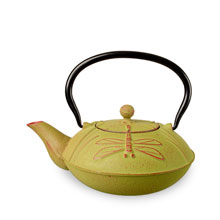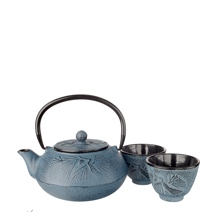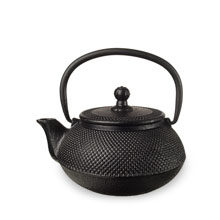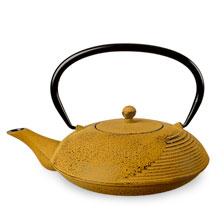Cast Iron Teapots: The Perfect Gift for Every Occasion
by Janelle Wazorick
February 22, 2023


Cast iron cookware is all the rage now, but what about cast iron teaware? Well, using cast iron in tea preparation is a long-held tradition! Though it has been used for tea preparation in Japan for centuries, in recent years western tea drinkers have adopted the use of cast iron teapots while enjoying a tea session. If you're looking to enhance your pot of Sencha or Genmai Cha, considering adding a cast iron teapot to your collection of teaware.
Cast Iron Teapots vs. Tetsubin
Let's address the giant tea bush in the room. When looking for a cast iron teapot, you'll no doubt run into the term tetsubin alongside cast iron teapot. While both terms refer to a pot-shaped tea accessory made out of iron, there are some differences between the cast iron teapots you often find in specialty tea shops and tetsubins.A tetsubin (or literally iron kettle) is a kettle you use to heat water for tea preparation. Traditionally, they are hung over a charcoal fire, but sometimes they are paired with a bowl-like brazier called a binkake. Testubins are often decorated with designs carved into the outside of the pot, but some can come plain as well. Even though they look like a teapot, tetsubins are only used to heat water with tea brewing occurring in a separate vessel.

Cast iron teapots are made to resemble tetsubins: they're made of iron, they often have designs engraved on them, and they're associated with tea preparation. However, that is where the similarities end. Cast iron teapots are made for tea preparation rather than heating water, and because of this, they often come with a removable infuser.
They are not suitable for heating water: the main reason for this is because the inside of the teapot is glazed with enamel. While enamel makes the teapots resistant to rust, it can crack when exposed directly to high temperatures during water boiling. While cast iron teapots are often referred to as tetsubin, they are not the same.
Why Use a Cast Iron Teapot?
From a practical standpoint, the biggest reasons to use a cast iron teapot is heat retention. Unlike teapots made of glass or ceramic, cast iron teapots will hold heat for a much longer length of time than teapots made from other materials. Of course, you may need to be careful with brewing more delicate teas that are sensitive to heat in cast iron, but if you enjoy having a couple cups of tea over a leisurely break, a cast iron teapot will maintain the temperature of the tea for a longer period of time.
From an aesthetic point, cast iron teapots are nice to look at, offering a traditional, rustic look to your tea experience. They come in different colors and different designs. You can find designs that reflect nature, like the Meguro Teapot or more geometric designs, like the Nara Teapot.
Tips For Brewing with a Cast Iron Teapot
Using a cast iron teapot to brew tea isn't much different from using ceramic or glass teapots, but there are a few tips to keep in mind for the best tea experience.Preheat the cast iron teapot before use. Preheating the teapot before brewing will help the teapot retain heat throughout your tea session. When you're ready to heat water for a tea session, pour some extra water in the kettle. When the water reaches the correct temperature, pour some of the heated water into the empty teapot (no infuser, no tea, nothing) and move the water so it comes in contact with most of the inside of the teapot. Once the teapot has been warmed (usually for a few moments, it's not an exact science), discard the water. Then brew tea in the teapot as usual.
Keep in mind water temperature for the tea you're brewing. As mentioned before, some teas are sensitive to higher water temperatures. Because cast iron retains heat, using the correct temperature when brewing in cast iron teapots is especially important. If brewing a tea for the first time in a cast iron teapot, start with a lower temperature and make changes for future brews.

Caring for Your Cast Iron Teapot
There are a couple of things to keep in mind when caring for a cast iron teapot. Though the inside of the teapot is typically glazed, rust becomes a concern for any teapots with an unglazed exterior. To prevent this:Make sure you clean your teapot immediately after use. And definitely don't let water sit in your teapot for a long period of time after your tea session is over.
Handwash the teapot. Do not put it in the dishwasher. I know the dishwasher is convenient, but if you want to use your cast iron teapot for years to come, hand wash it. Be careful about using harsh soaps to clean cast iron. If you can, just rinse it with hot water.
Author's Note: When I first got my cast iron teapot, I washed it with some mild dish soap as I do my other teaware. As long as you don't overdo the soap, you should be fine.
Dry the teapot immediately after washing. Since one of the things that causes rust is moisture, drying the teapot after washing will help prevent rust. Dry off as much water as you can with a towel and flip the teapot over and let it air dry the rest of the way.
If your teapot happens to develop rust (it happens; don't sweat it), simply clean the rust off with a soft brush or toothbrush.